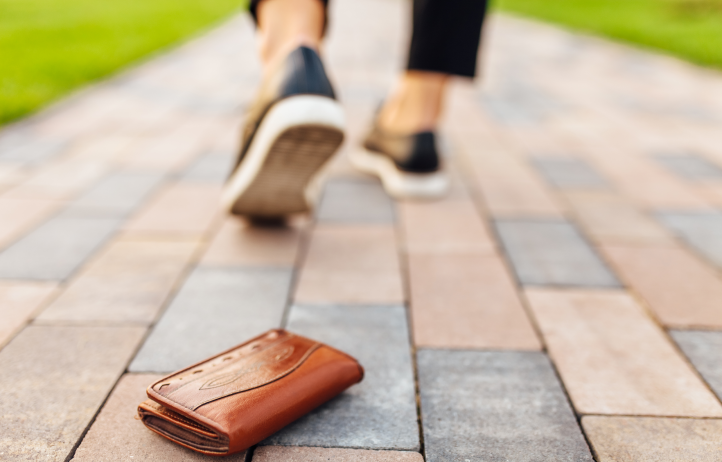TAKE ACTION TO MINIMIZE THE POTENTIAL DAMAGE
Have you ever had that sinking feeling that your wallet is missing, only to remember you left it on your kitchen table, or transferred it into your gym bag? If you’re fortunate enough to realize that you only misplaced it, you can breathe a huge sigh of relief. But what if it is actually missing? What do you do if you retrace your steps, checking all the possible places it could be and you discover that it’s really gone?
Prepare in Advance
Before crisis hits, one of the best things you can do for yourself is to take inventory of your wallet’s contents. We carry so many important cards with us, and if your wallet is gone these will all need to be replaced. When you are stressed out, worrying about your identification and access to your money falling into the wrong person’s hands, it can be hard to remember everything you had. By scanning the fronts and backs of cards and keeping them in a secure file, you’ll have card numbers and contact information you need readily available to begin making phone calls. However, if you haven’t had the chance to prepare for this scenario and find that your wallet has been lost or stolen, it’s time to take a deep breath and get to work right away on the following steps.
Steps to Take if it’s Gone
- Create a list. If you haven’t previously saved a file of the cards you carry, take a moment to jot down the contents you can remember. Items you might have had in your wallet include your driver’s license, credit cards, debit cards, checkbook, health insurance cards, cash, loyalty cards, library card and possibly your social security card and vaccination card (even though it’s better to leave these safely stored at home).
- Begin with the highest priority items. Contact your bank and your credit card issuers. Only use phone numbers printed on your statements or listed on official websites. Do not respond to any calls you may receive, as scammers can work quickly if they’ve gotten ahold of your wallet and could potentially contact you under the guise of offering help. It’s best to speak to a person and not just use an automated line. Explain to the customer service representative that your wallet was either lost or stolen. As they cancel and reissue new cards for you, they can make a record in your account to monitor for suspicious activity.
- File a police report. It’s not likely that this will result in the return of your wallet, however, this important document can be useful in establishing a record of the event. Should you become a victim of identity theft in the future, you can use it to help dispute invalid charges, loans fraudulently taken out in your name, or even someone attempting to collect tax refunds owed to you. If you find that your identity has been stolen, a police report will also assist you when filing a report on the FTC’s official site IdentityTheft.gov.
- Monitor your credit. Unfortunately, whether you’ve lost your wallet, or it has been stolen, one of the biggest concern you’ll face is the ongoing threat of your information in the wrong hands. Closely reviewing your credit reports can help you limit potential damage. You are allowed by law to see your information annually, for free, and can access it at AnnualCreditReport.com. Consider monitoring your reports from the three bureaus, Experian, TransUnion and Equifax, on a rotating schedule by requesting one free report every four months. Immediately notify the credit bureaus if you see any suspicious or incorrect activity, such as newly opened accounts that you did not initiate.
- You can also place a freeze on your credit. You can do this by contacting each of the three credit bureaus. This precaution will prevent lenders from accessing your credit and stop new loans or credit cards from being falsely issued in your name. If you choose to apply for credit, you have the ability to lift the freeze should you need to allow a lender to review your credit reports. Additionally, you should establish a fraud alert with the credit bureaus so that if anyone attempts to open a new account or loan, you’ll be contacted. As extra security, you may want to consider paying for a credit monitoring service.
- Place a freeze on your children’s credit to prevent child identity theft. If you carried any personal information about your children in your wallet, such as social security numbers or birthdates, a scammer may attempt to use it to open accounts in their name. Generally, children under 18 won’t have a credit report, but you can contact the credit bureaus and place a free credit freeze in your child’s name to make it difficult for their information to be used fraudulently.
- Replace your driver’s license. Check the website for your state’s Department of Motor Vehicles to learn what possible fees and documents are required to do this. The issuing state may choose to flag your license number in case someone else tries to use it.
- Replace your social security card by contacting the Social Security Administration. Be on guard for scammers who may contact you threatening that you will be arrested due to taxes or debt you owe. They may state they are from the IRS or use part or all of your Social Security number to convince you of this. The IRS will only contact you by official letter in the mail.
- Replace your vaccination card. State health departments distribute the Covid-19 Vaccination Record Cards to vaccination providers, who are in turn required to report administered vaccinations to the state’s Immunization Information System (IIS). If you have lost your card, you may contact your state health department by phone or email, or most vaccine providers can help you obtain a digital record of vaccinations.
- Notify your health insurance company and obtain new cards.
- Try to file your taxes early. The FTC warns that scammers may attempt tax identity theft where they use your Social Security number to get a tax refund or a job. A precaution you can take is to file your taxes before a scammer can. Be sure to respond quickly to any letters you receive from the IRS.
- Update subscriptions and automatic payment accounts. Think about automatic bill payments you may have established. Everything from your utilities, health insurance, car insurance and cell phone service to Hulu, Netflix and gym memberships may have been set up to receive payment from your debit or credit card that you are now replacing. Update your accounts with your new information to avoid service interruption or missed payments. This can be a good opportunity to create new, strong passwords for each account.
- Update online shopping accounts. Many online shopping sites let you store your payment information for future purchases. Remove any compromised cards and update your account with a new password.
- Consider changing your locks. Not everyone carries a spare key in their wallet, but some people do, and if you fall into this group, you will want to prevent someone who has your name and address from using your key to help themselves inside your home.
- Replace the less-important cards such as library and retail rewards cards.
- Be on guard for scams. Remain vigilant about protecting yourself from email and phone scams as information in your wallet may make it seem that a scammer is contacting you from a legitimate business. Never give out your personal information such as birthdate, social security number or pin numbers to anyone who has contacted you.
If you find yourself in the awful situation of missing your wallet, the best thing you can do is take immediate action and remain proactive in minimizing any potential fallout. If you’ve lost your wallet and have concerns about what you should do next, please contact us.


